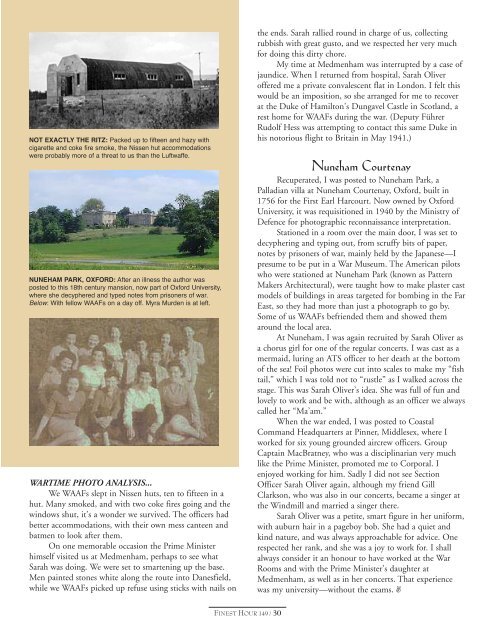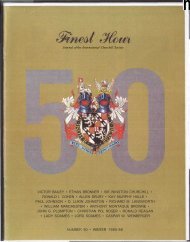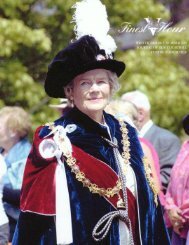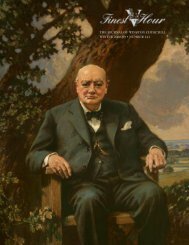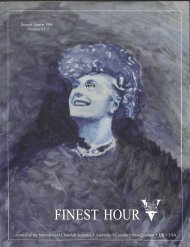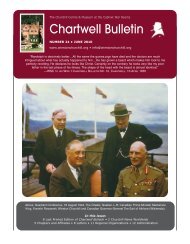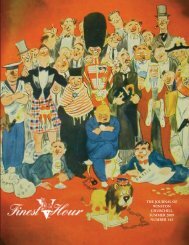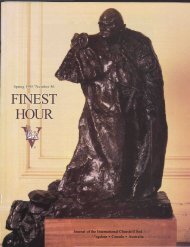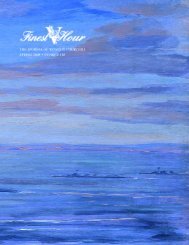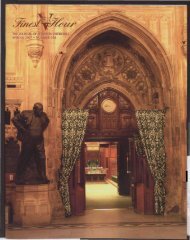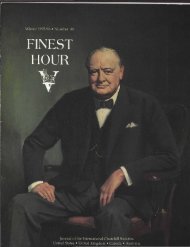Create successful ePaper yourself
Turn your PDF publications into a flip-book with our unique Google optimized e-Paper software.
NOT EXACTLY THE RITZ: Packed up to fifteen and hazy withcigarette and coke fire smoke, the Nissen hut accommodationswere probably more of a threat to us than the Luftwaffe.NUNEHAM PARK, OXFORD: After an illness the author wasposted to this 18th century mansion, now part of Oxford University,where she decyphered and typed notes from prisoners of war.Below: With fellow WAAFs on a day off. Myra Murden is at left.WARTIME PHOTO ANALYSIS...We WAAFs slept in Nissen huts, ten to fifteen in ahut. Many smoked, and with two coke fires going and thewindows shut, it’s a wonder we survived. The officers hadbetter accommodations, with their own mess canteen andbatmen to look after them.On one memorable occasion the Prime Ministerhimself visited us at Medmenham, perhaps to see whatSarah was doing. We were set to smartening up the base.Men painted stones white along the route into Danesfield,while we WAAFs picked up refuse using sticks with nails onthe ends. Sarah rallied round in charge of us, collectingrubbish with great gusto, and we respected her very muchfor doing this dirty chore.My time at Medmenham was interrupted by a case ofjaundice. When I returned from hospital, Sarah Oliveroffered me a private convalescent flat in London. I felt thiswould be an imposition, so she arranged for me to recoverat the Duke of Hamilton’s Dungavel Castle in Scotland, arest home for WAAFs during the war. (Deputy FührerRudolf Hess was attempting to contact this same Duke inhis notorious flight to Britain in May 1941.)Nuneham CourtenayRecuperated, I was posted to Nuneham Park, aPalladian villa at Nuneham Courtenay, Oxford, built in1756 for the First Earl Harcourt. Now owned by OxfordUniversity, it was requisitioned in 1940 by the Ministry ofDefence for photographic reconnaissance interpretation.Stationed in a room over the main door, I was set todecyphering and typing out, from scruffy bits of paper,notes by prisoners of war, mainly held by the Japanese—Ipresume to be put in a War Museum. The American pilotswho were stationed at Nuneham Park (known as PatternMakers Architectural), were taught how to make plaster castmodels of buildings in areas targeted for bombing in the FarEast, so they had more than just a photograph to go by.Some of us WAAFs befriended them and showed themaround the local area.At Nuneham, I was again recruited by Sarah Oliver asa chorus girl for one of the regular concerts. I was cast as amermaid, luring an ATS officer to her death at the bottomof the sea! Foil photos were cut into scales to make my “fishtail,” which I was told not to “rustle” as I walked across thestage. This was Sarah Oliver’s idea. She was full of fun andlovely to work and be with, although as an officer we alwayscalled her “Ma’am.”When the war ended, I was posted to CoastalCommand Headquarters at Pinner, Middlesex, where Iworked for six young grounded aircrew officers. GroupCaptain MacBratney, who was a disciplinarian very muchlike the Prime Minister, promoted me to Corporal. Ienjoyed working for him. Sadly I did not see SectionOfficer Sarah Oliver again, although my friend GillClarkson, who was also in our concerts, became a singer atthe Windmill and married a singer there.Sarah Oliver was a petite, smart figure in her uniform,with auburn hair in a pageboy bob. She had a quiet andkind nature, and was always approachable for advice. Onerespected her rank, and she was a joy to work for. I shallalways consider it an honour to have worked at the WarRooms and with the Prime Minister’s daughter atMedmenham, as well as in her concerts. That experiencewas my university—without the exams. ,FINEST HOUR 149 / 30


